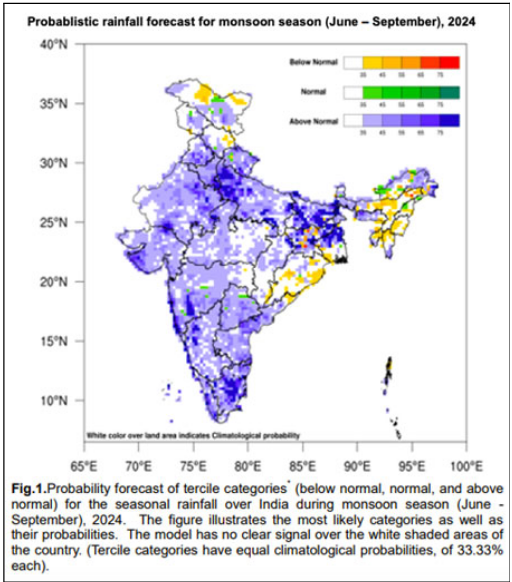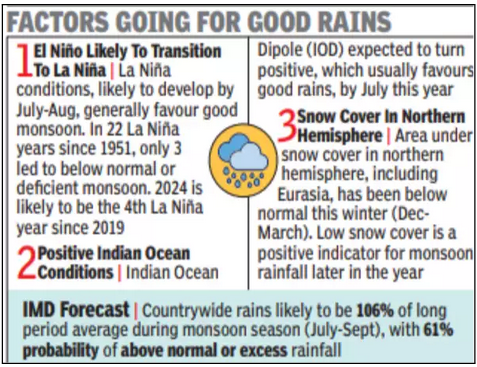GS Paper I
News Excerpt:
The India Meteorological Department (IMD) has forecast a bountiful monsoon for the year. The agency has forecast that the rains in June-September will be 6% more than the annual average of 87 cm during these months.
IMD's Monsoon Forecasting Approaches:
- The IMD uses multiple approaches to forecast the monsoon.
- One is to use statistical associations and draw upon its vast historical database of over 150 years to correlate certain global meteorological parameters such as ocean temperatures and snow cover in Europe etc. to the performance of the monsoon.
- The other way is to use the dynamical approach, or simulating the weather across the globe on a particular day, and having powerful computers extrapolate this data into the prediction for any future day or time period desired.
- Both these models indicated a similar outlook for the monsoon this year.

Rainfall forecast for the monsoon season (June – September), 2024:
- This is the first time, after a gap of eight years, that the IMD has forecast “above normal” rains in the country.
- This above-normal seasonal rainfall was “very likely” over most parts of the country, except in some areas over northwest, east, and northeast India, where below-normal rainfall was “very likely”.
- The seasonal rainfall over the country as a whole is likely to be 106% of the long-period average (LPA) with a model error of +/-5%
Categorization of Seasonal Rainfall:

- The LPA for the period between June and September is 87 centimeters (870 mm) and is calculated as the average rainfall between 1971-2020. By this calculation, there would be 92.2 cm of rainfall across India.
- The forecast suggests a 31% probability of an above-normal monsoon, a 29% probability of a normal monsoon, a 30% probability of an excess monsoon, an 8% probability of below normal monsoon, and only a 2% probability of a deficient monsoon.
Factors for the forecast of Rainfall:

- El-Nino and La-Nina: Currently, moderate El Niño conditions are prevailing over the equatorial Pacific region. Climate model forecasts indicate neutral conditions by the beginning of the monsoon season and La Niña conditions during the second half of the monsoon season.
- Indian Ocean Dipole: Currently, neutral Indian Ocean Dipole (IOD) conditions are prevailing. Climate model forecasts indicate positive IOD conditions likely to develop during the monsoon season.
- Snow Cover: Northern hemisphere snow cover extent during the last three months (January to March 2024) was below normal. Winter and spring snow cover extent over the Northern Hemisphere as well as Eurasia has a generally inverse relationship with the subsequent monsoon season rainfall.
|
Long Period Average:
|
Related News: Record-Breaking Temperatures Likely as El Nino Persists


